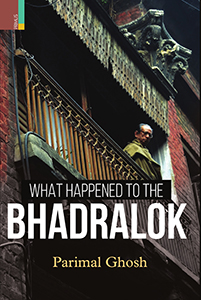
INFORMATION
- AUTHOR : Parimal Ghosh
- HB ISBN : 978-93-84082-99-4
- EBOOK ISBN : 978-93-84092-52-8
- HB Year : 2016, EBOOK Year : 2017
- Extent : 212 pp.
- Discount available on checkout
- Usually dispatched within 3 to 5 working days.
What Happened to the Bhadralok
| HB ₹ 1195 . $ . ₤ |
PB ₹ . $ . ₤ |
|
| POD ₹ . $ . ₤ |
e-Book ₹ . $ . ₤ |
INFORMATION
- AUTHOR – Parimal Ghosh
- ISBN – 978-93-84082-99-4
- Year – 2016
- Extent: 400 + 40 coloured illustrations
- 10% discount + free shipping
- Usually dispatched within 3 to 5 working days.
This book examines changes in several cultural markers of the Bengali bhadralok in the post-independence period and seeks to understand what they convey about present-day Bengali society. It argues that the bhadralok of the 1950s and 1960s had inherited a left-liberal view of politics and culture, the fruition of which was the leftist upsurge in West Bengal towards the closure of the 1960s. The decisive defeat of the left in recent years appears to have turned the bhadralok inward and made them more pragmatic. The dream of a comprehensive transformation of society, through constitutional means or otherwise, seems to have given way to a more down-to-earth approach in both their politics, and their everyday life. This change is evident not only in their cultural behaviour, whether it is their theatre or passion for football, but also in the way they live their lives in their neighbourhood or para, even their choice of detective stories. What Happened to the Bhadralok suggests that the arrival of new consumers of culture, drawn from the rural middle class, and the unorganized working-class and small business people from the city further accentuated this process: whether this has led to a proper democratization of our society is, however, a separate question.
The Author
Parimal Ghosh is Professor of South and South-East Asian Studies, University of Calcutta.
This book examines changes in several cultural markers of the Bengali bhadralok in the post-independence period and seeks to understand what they convey about present-day Bengali society. It argues that the bhadralok of the 1950s and 1960s had inherited a left-liberal view of politics and culture, the fruition of which was the leftist upsurge in West Bengal towards the closure of the 1960s. The decisive defeat of the left in recent years appears to have turned the bhadralok inward and made them more pragmatic. The dream of a comprehensive transformation of society, through constitutional means or otherwise, seems to have given way to a more down-to-earth approach in both their politics, and their everyday life. This change is evident not only in their cultural behaviour, whether it is their theatre or passion for football, but also in the way they live their lives in their neighbourhood or para, even their choice of detective stories. What Happened to the Bhadralok suggests that the arrival of new consumers of culture, drawn from the rural middle class, and the unorganized working-class and small business people from the city further accentuated this process: whether this has led to a proper democratization of our society is, however, a separate question.
The Author
Parimal Ghosh is Professor of South and South-East Asian Studies, University of Calcutta.
Table of Contents
Table of Contents
| Acknowledgements | Xi-Xii |
| Introduction | 1-11 |
| Critique Of The Bhadralok And The Bhadralok Critic | 12-42 |
| Calcutta’s Bengali Theatre: An Account Of The Real And The Iconic | 43-66 |
| Was There A Muslim Bhadralok: A Reading Of Selected Texts | 67-105 |
| A Passage Of Football | 106-130 |
| From Byomkesh To Feluda: The Strange Life Of The Bengali Detective | 131-160 |
| My Grandfather’s House And Some Thoughts On Kolkata’s Para | 161-180 |
| Where Have All The Bhadraloks Gone? | 181-188 |
| Bibliography | 189-194 |
| Index | 195-200 |




